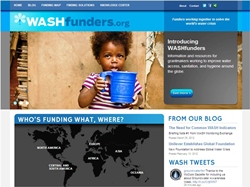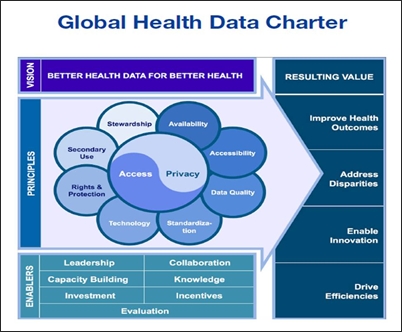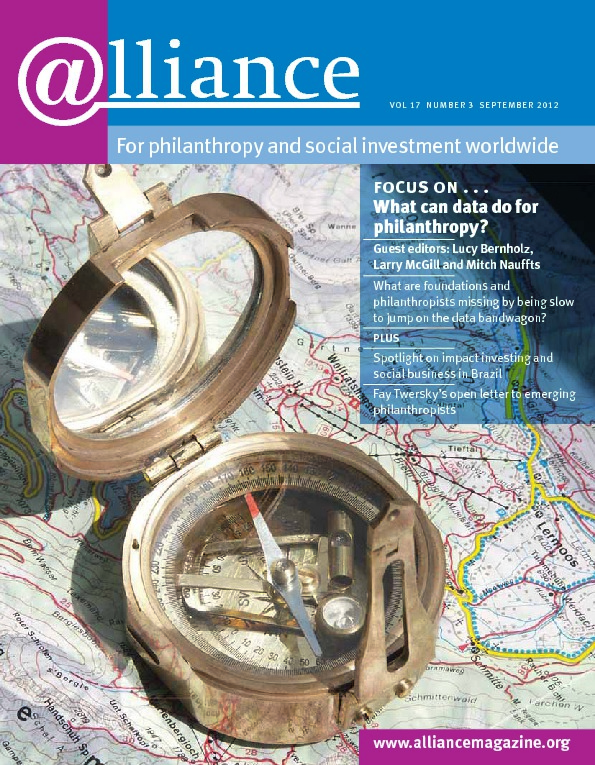So, on top of everything else, foundations are supposed to compile and maintain data on their activities? And share it with other foundations? And perhaps even make it public? And do all of this willingly, because it will make philanthropy more effective? It is up to foundations to decide whether or not to do this, but it is becoming clearer every day that the answer is being thrust upon them, whether foundations are ready or not.
 It is impossible to escape the notion that we have entered the world of ‘Big Data’. The financial industry, corporations, marketing firms, bilateral and multilateral organizations, and even governments are moving proactively to take advantage of information technology that allows data to be rapidly and efficiently collected, processed, organized, accessed, and put into the service of maximizing profits, gathering market intelligence and optimizing the flow of international aid, among other things. More than 300,000 businesses currently subscribe to data services provided by New York-based Bloomberg LP, which has captured a third of what has become a $16 billion financial data market. The OECD (Organization for Economic Cooperation and Development), whose stated objective is to produce analyses and policy recommendations that are ‘independent and evidence-based’, works with 34 member countries to collect and make publicly available real-time data on hundreds of economic, political and social measures.
It is impossible to escape the notion that we have entered the world of ‘Big Data’. The financial industry, corporations, marketing firms, bilateral and multilateral organizations, and even governments are moving proactively to take advantage of information technology that allows data to be rapidly and efficiently collected, processed, organized, accessed, and put into the service of maximizing profits, gathering market intelligence and optimizing the flow of international aid, among other things. More than 300,000 businesses currently subscribe to data services provided by New York-based Bloomberg LP, which has captured a third of what has become a $16 billion financial data market. The OECD (Organization for Economic Cooperation and Development), whose stated objective is to produce analyses and policy recommendations that are ‘independent and evidence-based’, works with 34 member countries to collect and make publicly available real-time data on hundreds of economic, political and social measures.
At the same time, calls for ‘opening’ existing proprietary data sets for public consumption have been proliferating, on the theory that independent software developers will be able to build new applications that allow users to access the data in ways that go far beyond any possibilities originally envisioned by the data collectors themselves. In that spirit, the World Bank recently opened up for public access data on more than 8,000 indicators from its massive statistical database.
As these transformative developments in information technology are taking place, what is philanthropy doing to take advantage of them? Does philanthropy have a plan for building the kind of knowledge base and knowledge tools that will allow it to identify areas of need, emerging trends, key actors and institutions engaging in social investment activities, patterns and gaps in the provision of aid and other types of support, intervention strategies that work and don’t work, and opportunities for collaboration to improve on-the-ground impact?
The payoffs of having data
Collecting data on philanthropy around the world is no small challenge. As European Foundation Centre (EFC) chief executive Gerry Salole explains in another article in this special feature, just trying to count the total number of foundations in Europe is ‘an impossible task given the level of differences that exist between foundations within a given European country, not to mention across borders, and the constantly mutating and changing contexts in which they operate’. Moreover, one might fairly ask, how does knowing the total number of foundations in Europe help foundations do their work anyway?
Supporting advocacy
While it may not be relevant to the work of any one foundation, it is certainly relevant to foundations collectively. A European Foundation Statute that has the potential to facilitate the work of more than 100,000 foundations representing total annual expenditures of more than €50 billion (a back-of-the-envelope estimate derived from published information on the EFC website), is more likely to pass than a statute that has the potential to facilitate the work of an unknown number of foundations. The work of the EFC and the recently formed Foundation Council of Europe can harness the persuasive power of large numbers only if the numbers are known.
 For market intelligence
For market intelligence
For an individual foundation, though, what is most important is ‘market intelligence’, to borrow a phrase from business. That means understanding potential constituencies, unmet needs among those constituencies, mechanisms for meeting those needs, and the work of other organizations operating in that market.
Understanding potential constituencies means compiling data on who they are. Where do they live? What do they look like demographically? How do they fit into the larger social, cultural and economic environment in which they are situated?
Understanding unmet needs among those constituencies means compiling data on the scope of the problems or issues that disproportionately affect them. How are specific constituencies (eg women, people of colour, rural populations and people with disabilities) affected by these problems or issues?
Understanding mechanisms for meeting the needs of constituencies means understanding what types of intervention have been tried and with what levels of success.
Understanding the work of other organizations operating in the same ‘market’ means compiling data on the activities of other foundations, as well as bilateral and multilateral organizations that are working on these problems or issues. What are their theories of change? What types of interventions are they engaged in? What organizations on the ground do they work with? How does the work of your foundation fit into this picture?
Having access to data in each of these areas minimizes the risk of making poor investment decisions. Put another way, data give foundations their best shot at making a difference through their work. Just as in the business world, though, this does not guarantee impact. Nor does it eliminate risk. Minimizing risk is the only thing that foundations have any power to control.
For monitoring and learning
Once funds have been expended, there is little that foundations can do to further influence the course that events will take. The ‘market’ will do as it will, as the funds catalyse events, actions and reactions among the constituencies that are touched by the work. But what foundations can do once funds have been released is monitor the work and learn from the consequences generated by it. And that, once again, calls for the collection of data.
Just as gathering ‘market intelligence’ on what has been tried and what works is part of the due diligence that foundations must do before developing and implementing their intervention strategies, they owe it to the field to collect and share data on how well their own interventions actually worked, so others can do their due diligence as well. There must be collective learning as well as individual learning.
In short, the two most powerful tools foundations have for maximizing the impact of their investments are minimizing risk and drawing lessons from consequences. And both of these require data.
Who is collecting data on philanthropy and why?
To solve global problems, foundations need global data. Organizations such as the OECD, the World Bank, the World Health Organization and the United Nations have developed databases that can help foundations better understand their potential constituencies and their needs. But what kinds of information are available on the activities of foundations themselves?
While individual foundations may share some of this information through annual reports, websites and other means, it is impossible to understand the net impact of the work of foundations without engaging in systematic efforts to collect data across foundations in general. The need for this kind of systematic data on foundation activities has become increasingly salient to associations of foundations that seek to develop services to meet their members’ needs.
There are more than 100 associations of foundations around the world, most of them organized on a national or regional basis. Most have been around for less than 15 years and are still discovering the best ways to serve their members. Almost all are engaged in collecting member data on a regular basis, sometimes annually, sometimes less often. What are they collecting data on? Are they asking the same types of question? Can we learn anything about the work of philanthropy worldwide by merging the data collected across associations?
As part of our work with the WINGS Philanthropy Data Network, we looked at a sample of seven surveys that foundation associations are using to collect data from their members, in Australia, Colombia, Mexico, Minnesota (US), Spain, Ukraine and the UK. (We are collecting additional surveys and will extend this analysis further as additional materials are received.) The number of questions asked on each survey ranged from 28 to 55.
Across these seven surveys, how many questions were asked in common by all? The answer is one: what geographic area(s) does your foundation serve? Beyond this, six of the seven surveys asked for the name of the foundation and the foundation’s areas of interest. Five asked for the foundation’s establishment date, the size of its staff, and ‘any other comments’.
Clearly, we are a long way from systematic global data collection on foundation activities. We cannot yet build a comprehensive picture of global philanthropy based on current data collection efforts.
 There are bright spots, however. In 2010, for example, the China Foundation Center was established in Beijing. In less than two years, the CFC has collected, and made publicly available, data on more than 2,000 Chinese foundations, which can be viewed at en.foundationcenter.org.cn.
There are bright spots, however. In 2010, for example, the China Foundation Center was established in Beijing. In less than two years, the CFC has collected, and made publicly available, data on more than 2,000 Chinese foundations, which can be viewed at en.foundationcenter.org.cn.
And recently developed data-driven knowledge tools are starting to transform the way foundations work together. In October 2011, with support from the Hilton Foundation, the Foundation Center launched WASHfunders.org, a custom web portal that serves as a hub of information and resources for funders working around the world to improve water access, sanitation and hygiene – commonly referred to as ‘WASH’. The site brings together and organizes data from diverse sources, including foundations, the World Bank and the OECD, so the community of funders can more effectively, and collectively, meet this urgent global challenge.
Through WASHfunders.org, foundations have free and unrestricted access to a broad set of data-rich resources including:
- a mapping tool that enables users to interact with data on international aid flows, foundation funding, and key development indicators;
- profiles documenting the WASH strategies of leading foundations;
- case studies that illustrate the successes and challenges of WASH projects around the world;
- tools and resources for assessing project outcomes; and
- a searchable archive of research reports recommended by sector leaders.
 Steven Hilton, president and CEO of the Conrad N Hilton Foundation, a leading funder of water issues, expects WASHfunders.org to ‘play a vital role in promoting effectiveness, increasing collaboration, and facilitating decision making within the donor community. [It] will help bring more visibility to the global water crisis, attract new partners and funders, and fill a key gap in the effort to meet the global WASH challenges.’
Steven Hilton, president and CEO of the Conrad N Hilton Foundation, a leading funder of water issues, expects WASHfunders.org to ‘play a vital role in promoting effectiveness, increasing collaboration, and facilitating decision making within the donor community. [It] will help bring more visibility to the global water crisis, attract new partners and funders, and fill a key gap in the effort to meet the global WASH challenges.’
Less than a year from the launch of WASHfunders.org, its early success has spawned initiatives to develop half a dozen new knowledge portals, on topics such as media, sustainable arts organizations and funding for black men and boys. Foundations are quickly discovering that knowledge tools such as WASHfunders.org allow them to be more strategic, enabling them to make data-driven decisions and share peer-to-peer insights much more effectively.
Improving data on philanthropy
If foundations are to participate fully in the data revolution, they need to overcome the natural tendency to build and work within systems that serve only their internal needs. When 100 foundations are using 100 idiosyncratic methods to describe and monitor their own work, it is impossible to share learnings across organizations efficiently. And the field as a whole cannot become more effective.
Philanthropy is not the only field struggling with these issues. In a domain where the stakes are arguably even higher than in philanthropy, health organizations are coming to grips with the fact that accurate health data are not always available when and where they are needed. A recent manifesto published by the World Economic Forum, called the Global Health Data Charter, points out that ‘lack of data can lead to ineffective or unsafe delivery of services, poor patient choices and wasted resources. Effective management of health data is a prerequisite to achieve individual treatment and population health management goals, along with those for overall health system performance [emphasis added].’

The Global Health Data Charter articulates a simple yet powerful vision for the development of health data standards (‘Better health data for better health’); a set of principles to guide the development of standards; an action plan that describes the enablers required to ensure the successful implementation of standards; and a picture of the resulting value that data standards will create.
A global philanthropy data charter?
As foundations and philanthropic associations grapple with these same issues, perhaps it is time for philanthropy to develop its own data charter, laying out in clear terms the ‘vision, principles, enablers, and resulting value’ that underlie a commitment to establishing common data standards for the field. At the same time, the field needs to be aware that a number of emerging models are already gaining traction (such as IATI, the International Aid Transparency Initiative, which has begun integrating data on the work of foundations into its scheme), while many country-specific initiatives are also moving forward at a brisk pace. In short, the will to collect philanthropic data is widespread, and time is short to develop and adopt global data collection standards of maximum utility to philanthropy.
But as the field works towards the development of data standards, a final important concern needs to be acknowledged. Standards must not be incompatible with flexibility. Philanthropy, though similar in many respects around the world, is not monolithic. While many of its basic features can be described using standardized categories, it inevitably retains the stamp of the individual organizations and cultures from which it flows, as it should. Yes, this makes the job of developing global data standards more difficult, but it should not be used as an excuse for not building standards or collecting data at all. Just as in the health field, the stakes are much too high in philanthropy to operate without having the best available information at its disposal.
Conclusion
In a recent blog post, ‘Philanthropy’s Data Dilemma’, Foundation Center president Bradford Smith said: ‘Getting foundations into the era of Big Data doesn’t have to be a Herculean challenge. Technology is on our side and stopping doing some things will free up time and resources to do others.’ While he is speaking primarily to an audience of US foundations, the principles he articulates apply to all:
- STOP trying to be unique.
- START aligning your data with the outside world.
- STOP developing custom grants management systems.
- START going beyond the minimum reporting requirements of tax laws.
- STOP thinking about data and communications as two separate things.
- START thinking about data as open.
There is a theory of change underlying the recommendation that foundations join the ‘Big Data’ movement. And like all theories of change relating to philanthropy, its goal is to maximize the impact of philanthropic work. We don’t encourage the collection and use of data for data’s sake or even as a way of improving the efficiency of foundation practices, though these goals are fine. At bottom, the ultimate beneficiaries of improved data on philanthropy are, in fact, the very people that foundations are trying to reach through their charitable activities.
Larry McGill is vice president for research at the Foundation Center and one of the guest editors for the Alliance special feature ‘What can data do for philanthropy?’ Email ltm@foundationcenter.org.

Receiving mobile phone updates on current market prices, weather forecasts, etc helps smallholder farmers to negotiate better prices and to decide when and where to take their products to market, and ultimately improves their incomes.





Comments (0)